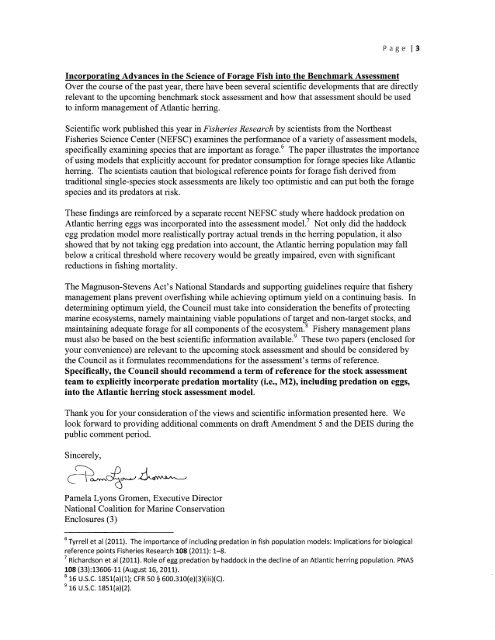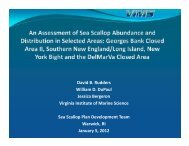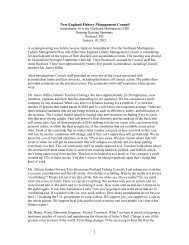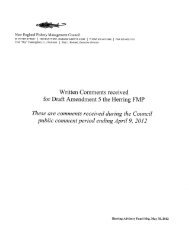Correspondence/Amendment 5 Comments - New England Fishery ...
Correspondence/Amendment 5 Comments - New England Fishery ...
Correspondence/Amendment 5 Comments - New England Fishery ...
Create successful ePaper yourself
Turn your PDF publications into a flip-book with our unique Google optimized e-Paper software.
Page l3<br />
Incorporating Advances in the Science of Forage Fish into the Benchmark Assessment<br />
Over the course of the past year, there have been several scientific developments that are directly<br />
relevant to the upcoming benchmark stock assessment and how that assessment should be used<br />
to inform management of Atlantic herring.<br />
Scientific work published this year in Fisheries Research by scientists from the Northeast<br />
Fisheries Science Center (NEFSC) examines the performance of a variety of assessment models,<br />
specifically examining species thatarc important as forage.6 The paper illustrates the importance<br />
of using models that explicitly account for predator consumption for forage species like Atlantic<br />
herring. The scientists caution that biological reference points for forage fish derived from<br />
traditional single-species stock assessments are likely too optimistic and can put both the forage<br />
species and its predators at risk.<br />
These findings are reinforced by a separate recent NEFSC study where haddock predation on<br />
Atlantic herring eggs was incorporatèd into the assessment model.T Not only did the haddock<br />
egg predation model more realistically portray actual trends in the herring population, it also<br />
showed that by not taking egg predation into account, the Atlantic herring population may fall<br />
below a critical threshold where recovery would be greatly impaired, even with significant<br />
reductions in fishing mortality.<br />
The Magnuson-Stevens Act's National Standards and supporting guidelines require that fishery<br />
management plans prevent overfishing while achieving optimum yield on a continuing basis. In<br />
determining optimum yield, the Council must take into consideration the benefits of protecting<br />
marine ecosystems, namely maintaining viable populations of target and non-target stocks, and<br />
maintaining adequate forage for all components oi the ecosystem.s <strong>Fishery</strong> management plans<br />
must also be based on the best scientific information available.' These two papers (enclosed for<br />
your convenience) are relevant to the upcoming stock assessment and should be considered by<br />
the Council as it formulates recommendations for the assessment's terms of reference.<br />
SpecifÌcally, the Council should recommend a term of reference for the stock assessment<br />
team to explicitly incorporate predation mortality (i.e., M2), including predation on eggs,<br />
into the Atlantic herring stock assessment model.<br />
Thank you for your consideration of the views and scientific information presented here. We<br />
look forward to providing additional comments on draft <strong>Amendment</strong> 5 and the DEIS during the<br />
public comment period.<br />
Sincerely,<br />
e^{"-,¡"*-<br />
Pamela Lyons Gromen, Executive Director<br />
National Coalition for Marine Conservation<br />
Enclosures (3)<br />
6Tyrrell<br />
etal (2011). Theimportanceof includingpredationinfishpopulationmodels:lmplicationsforbiological<br />
reference points Fisheries Research 108 (2011): 1-8.<br />
7<br />
Richardson et al (2011). Role of egg predation by haddock in the decline of an Atlantic herring population. PNAS<br />
108 (33):13606-11 (August t6, z0tll.<br />
'16 u.s,c. 18sl(aX1); cFR so S 600.310(e)(3Xii¡Xc).<br />
'16 u.s.c. 18s1(aX2).







